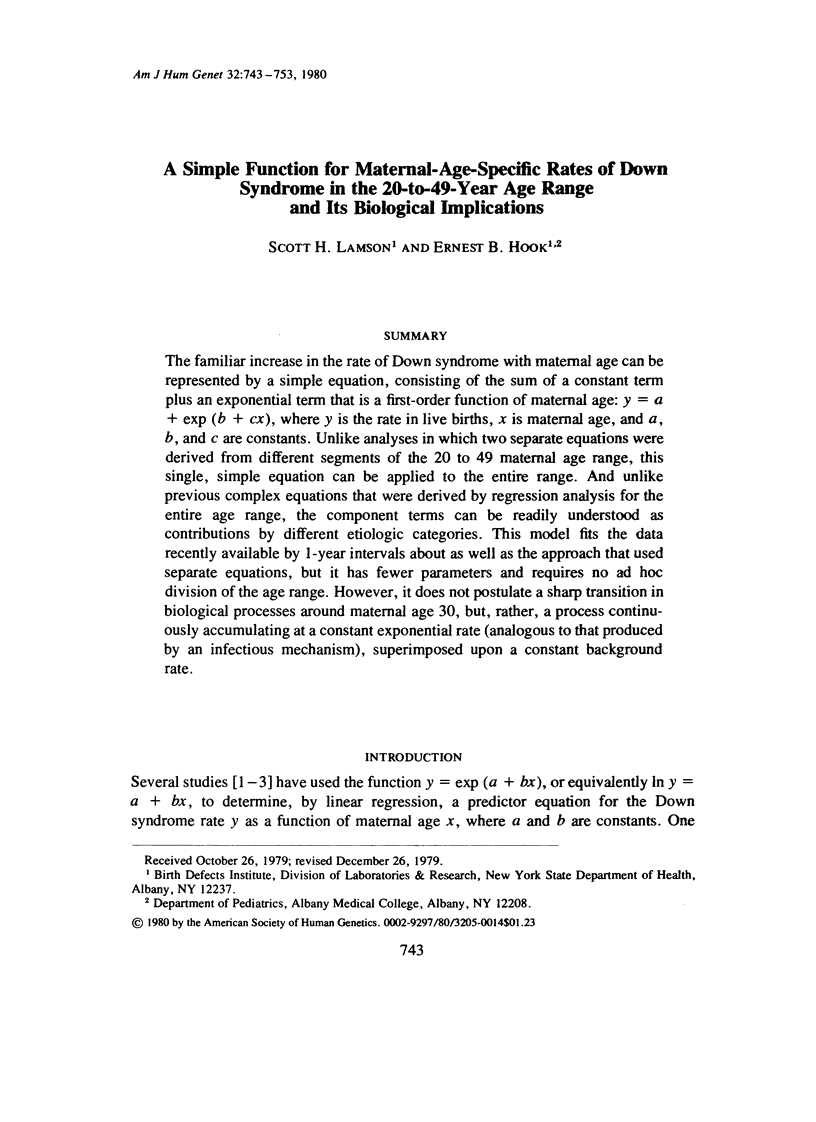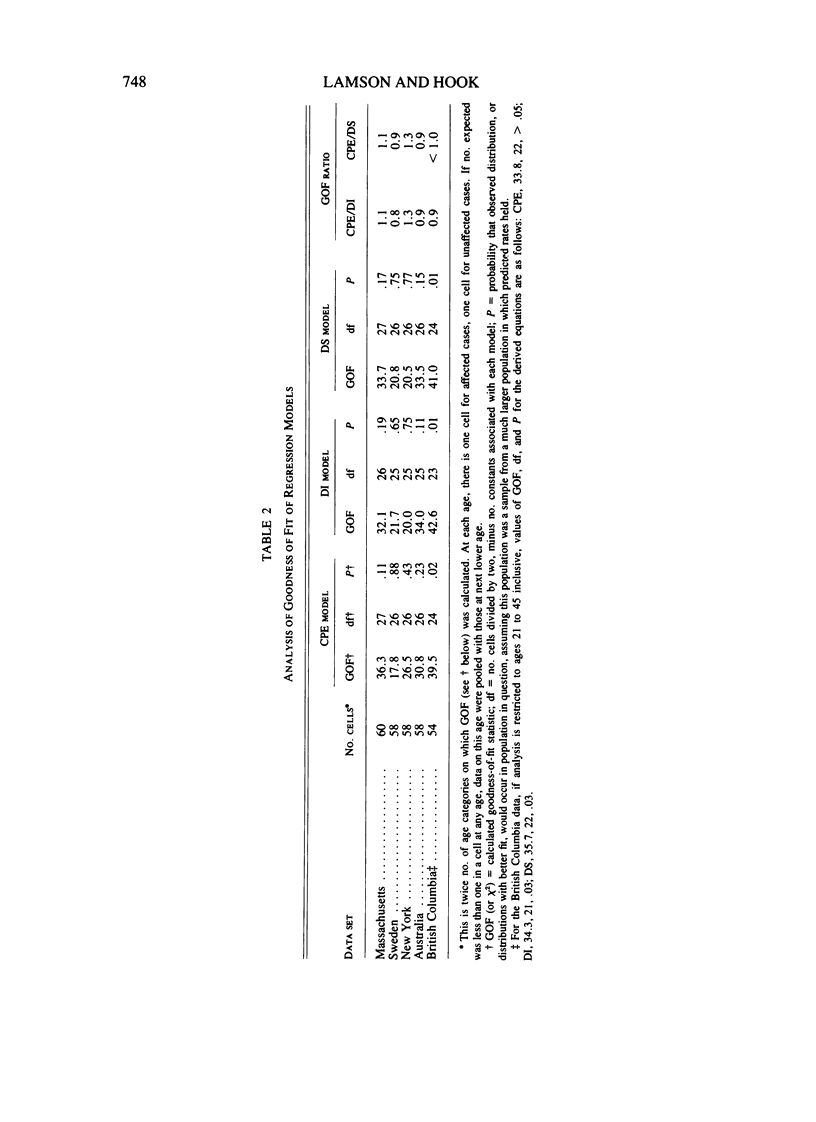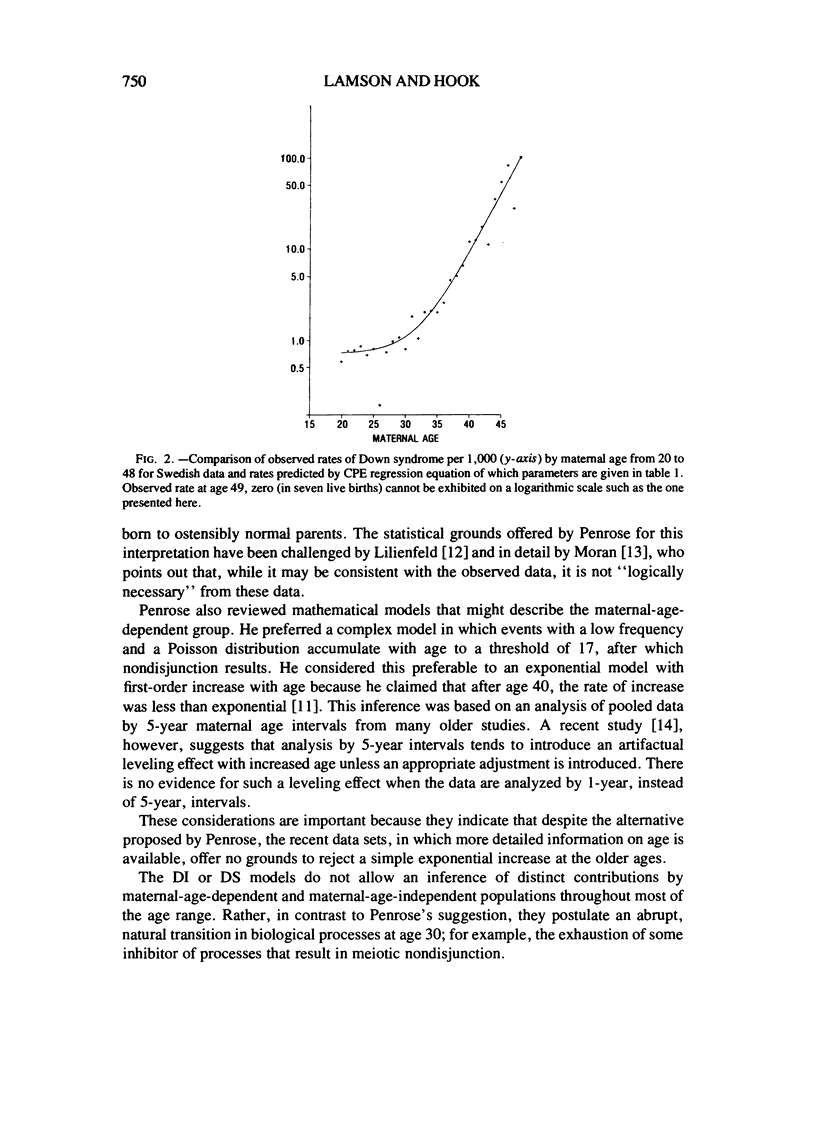Abstract
The familial increase in the rate of Down syndrome with maternal age can be represented by a simple equation, consisting of the sum of a constant term plus an exponential term that is a first-order function of masternal age: y = a + exp (b + cx), where y is the rate in live births, x is maternal age, and a, b, and c are constants. Unlikely analyses in which two separate equations were derived from different segments of the 20 to 49 maternal age range, this single, simple equation can be applied to the entire range. An unlike previous complex equations that were derived by regression analysis for the entire age range, the component terms can be readily understood as contributions by different etiologic categories. This model fits the data recently available by 1-year intervals about as well as the approach that used separate equations, but it has fewer parameters and requires no ad hoc division of the age range. However, it does not postulate a sharp transition in biological processes around maternal age 30, but, rather, a process continuously accumulating at a constant exponential rate (analogous to that produced by an infectious mechanism), superimposed upon a constant background rate.
Full text
PDF










Selected References
These references are in PubMed. This may not be the complete list of references from this article.
- Erickson J. D. Down syndrome, paternal age, maternal age and birth order. Ann Hum Genet. 1978 Jan;41(3):289–298. doi: 10.1111/j.1469-1809.1978.tb01896.x. [DOI] [PubMed] [Google Scholar]
- Hook E. B., Chambers G. M. Estimated rates of Down syndrome in live births by one year maternal age intervals for mothers aged 20-49 in a New York State study-implications of the risk figures for genetic counseling and cost-benefit analysis of prenatal diagnosis programs. Birth Defects Orig Artic Ser. 1977;13(3A):123–141. [PubMed] [Google Scholar]
- Hook E. B., Fabia J. J. Frequency of Down syndrome in livebirths by single-year maternal age interval: results of a Massachusetts study. Teratology. 1978 Jun;17(3):223–228. doi: 10.1002/tera.1420170303. [DOI] [PubMed] [Google Scholar]
- Hook E. B., Lamson S. H. Rates of Down's syndrome at the upper extreme of maternal age--absence of a "leveling" effect and evidence for artifacts resulting from analyses of rates by five-year maternal age intervals. Am J Epidemiol. 1980 Jan;111(1):75–80. doi: 10.1093/oxfordjournals.aje.a112876. [DOI] [PubMed] [Google Scholar]
- Hook E. B., Lindsjö A. Down syndrome in live births by single year maternal age interval in a Swedish study: comparison with results from a New York State study. Am J Hum Genet. 1978 Jan;30(1):19–27. [PMC free article] [PubMed] [Google Scholar]
- Lindsjö A. Down's syndrome in Sweden. An epidemiological study of a three-year material. Acta Paediatr Scand. 1974 Jul;63(4):571–576. doi: 10.1111/j.1651-2227.1974.tb04849.x. [DOI] [PubMed] [Google Scholar]
- Matsunaga E., Tonomura A., Oishi H., Kikuchi Y. Reexamination of paternal age effect in Down's syndrome. Hum Genet. 1978 Feb 16;40(3):259–268. doi: 10.1007/BF00272186. [DOI] [PubMed] [Google Scholar]
- Moran P. A. Are there two maternal age groups in Down's syndrome? Br J Psychiatry. 1974 May;124(0):453–455. doi: 10.1192/bjp.124.5.453. [DOI] [PubMed] [Google Scholar]
- Stene J., Fischer G., Stene E., Mikkelsen M., Petersen E. Paternal age effect in Down's syndrome. Ann Hum Genet. 1977 Jan;40(3):299–306. doi: 10.1111/j.1469-1809.1977.tb00194.x. [DOI] [PubMed] [Google Scholar]
- Sutherland G. R., Clisby S. R., Bloor G., Carter R. F. Down's syndrome in South Australia. Med J Aust. 1979 Jul 28;2(2):58–61. doi: 10.5694/j.1326-5377.1979.tb112703.x. [DOI] [PubMed] [Google Scholar]
- Trimble B. K., Baird P. A. Maternal age and Down syndrome: age-specific incidence rates by single-year intervals. Am J Med Genet. 1978;2(1):1–5. doi: 10.1002/ajmg.1320020102. [DOI] [PubMed] [Google Scholar]
- Zellweger H., Simpson J. Is routine prenatal karyotyping indicated in pregnancies of very young women? J Pediatr. 1973 Apr;82(4):675–677. doi: 10.1016/s0022-3476(73)80595-5. [DOI] [PubMed] [Google Scholar]


